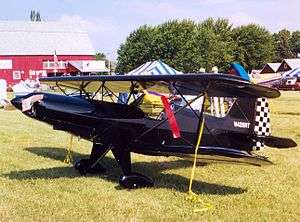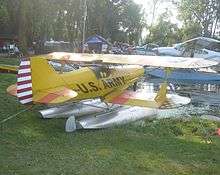Green Sky Adventures Micro Mong
The Green Sky Adventures Micro Mong is an ultralight biplane based on the Mong MS1 Sport.
| Green Sky Adventures Micro Mong | |
|---|---|
 | |
| Micro Mong | |
| Role | Ultralight aircraft |
| National origin | United States of America |
| Manufacturer | Green Sky Adventures |
| Designer | Ed Fisher |
| First flight | 1993 |
| Introduction | 1993 |
| Number built | 19 (2011)[1] |
| Unit cost |
$13388 US dollar in 1996 for kit with Rotax 503 |
| Developed from | Mong Sport (Configuration only) |
Development
Ed Fisher, an avid compiler of Mong Sport history, in 1981 met with designer Ralph Mong. After the completion of the Fisher Skylite, Fisher suggested building an ultralight version of the Mong Sport. A custom built ultralight prototype was built for Fisher, called the Travelight. A second model was constructed, built for pilots up to 6' 2" (188 cm), which became known as the Mico Mong.[2]
Design
The fuselage is welded 4130 steel tubing. The front wing spars are 2.5 in (6.4 cm) aluminum tubing, with aluminum ribs and aircraft fabric covering. If equipped with a Rotax 277 engine, the aircraft meets American FAR 103 Ultralight Vehicle standards, by weighing less than 254 lb (115 kg). The wing area of the ultralight version is larger than the heavier Mong Sport it replicates, in order to keep the stall speed low.[2][3][4]
Operational history

A Micro Mong floatplane recorded the fastest seaplane takeoff of 2.5 seconds at the Experimental Aircraft Association airshow in 2008.[5]
Variants
- Micro Mong 2XF
- Powered by a HKS 700E 2 cylinder 4-stroke air-cooled engine.
- Raceair Lil Bitts
- Developed at the same time by Fisher using a deeper Micro Mong fuselage to resemble a Pitts Special.[6]
Specifications (Micro Mong)
Data from Green Sky Adventures
General characteristics
- Length: 14 ft (4.3 m)
- Wingspan: 19 ft 6 in (5.94 m)
- Height: 6 ft (1.8 m)
- Wing area: 100 sq ft (9.3 m2)
- Airfoil: Modified Clark Y
- Empty weight: 400 lb (181 kg)
- Gross weight: 600 lb (272 kg)
Performance
- Maximum speed: 96 kn (110 mph, 180 km/h)
- Cruise speed: 70 kn (80 mph, 130 km/h)
- Stall speed: 30 kn (35 mph, 56 km/h)
References
| Wikimedia Commons has media related to Micro Mong. |
- Vandermeullen, Richard: 2012 Kit Aircraft Buyer's Guide, Kitplanes, Volume 28, Number 12, December 2011, page 56. Belvoir Publications. ISSN 0891-1851
- "Reinventing the Mong". Sport Aviation. Feb 1994.
- Bayerl, Robby; Martin Berkemeier; et al: World Directory of Leisure Aviation 2011-12, page 104. WDLA UK, Lancaster UK, 2011. ISSN 1368-485X
- Tacke, Willi; Marino Boric; et al: World Directory of Light Aviation 2015-16, page 110. Flying Pages Europe SARL, 2015. ISSN 1368-485X
- "Micro Mong that holds fastest takeoff record of 2.5 seconds at Seaplane Base". Sport Aviation. September 2008.
- "Raceair Lil Bitts". Archived from the original on 6 February 2012. Retrieved 10 August 2012.